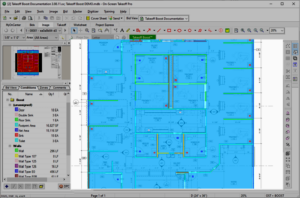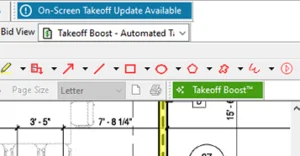OK, it’s time to learn the new takeoff and estimating software that your company recently purchased. But where do you start? How big of a learning curve will you face? How long will your ramp-up take?
If you’re asking these questions, you’re not alone. Most estimators, project managers, and other construction-industry professionals share these concerns when faced with tackling new software tools. In truth, this process can be pretty painless if you follow a few fundamental guidelines.
Here are six steps to keep in mind to get the most out of your training and investment in new software:
Prioritize Your Time
For starters, most companies offer training along with your software purchase. In many cases, this training will be online; in others, it may be in person. Regardless of the format, it’s likely your boss will want you to begin using the new software as soon as possible. You should be sure to get as much information as you can about your training options.
In fact, the more you know about your training options, the more comfortable you’ll feel about not having to learn the new tools in a vacuum. If possible, consider asking your boss if they can prioritize your schedule so you can focus on learning for a fixed period—without too many other distractions.
Sure, this scenario isn’t always doable, but carving out some dedicated time could decrease your overall ramp-up and help you achieve your goals more quickly.
Ponder Your Goals
It’s important to know what you’re hoping to take away from the training. If you have specific objectives, go ahead and share them with your trainer before or, at least, at the beginning of your training session.
As such, this allows your trainer to cover the prescribed curriculum, as well as any topics of special interest to you. It reminds me of that famous quote from the movie Jerry Maguire, “help me (your trainer), help you.”
Remember, our main purpose is to help you succeed so let us know what your needs are for training. Even if it’s a topic that requires a little research, we’ll be happy to do that and get back to you with answers as soon as possible.
Pick a Good Location
When the time comes for the (online) training session, find a quiet area. If possible, somewhere you can close the door. If you’re in the office where you can still hear co-workers talking or phones ringing or other ambient noise, your concentration may be affected.
If you can go into a room alone, close the door, and focus only on learning, your ability to comprehend the new tools will increase dramatically.
Double-Check Your Technology
When you find a suitable place, double-check your technology setup. If the training is online, be sure you have good internet connectivity. (Trainings are conducted using online meeting software so make sure your computer/internet can handle running that and the takeoff and estimating software simultaneously.) If your bandwidth isn’t strong enough, consider using a hard-wired connection during the session.
If you’ll be using a laptop, have your power cable nearby. (You don’t want your computer to die halfway through the training.) In addition, be sure to bring a mouse. Using takeoff and estimating software with only a trackpad is challenging – at best. That mouse will be important, especially when you’re performing takeoffs.
Likewise, be sure to test your audio capabilities. For example, if you’re planning to use the audio on your computer, find out if your computer has a microphone. If it does, you’re all set. If not, consider using your phone instead. And, if you’ll be dialing in, try to use a headset. If you prefer to use a speakerphone, it’s best if you’re in a quiet area free from other noise.
Lastly, make sure you have a notepad. You may want jot down key points or takeaways. Many times, I’ve had people ask me to pause so they can take notes about what we’re discussing. I’m always happy to oblige that request, as writing things down almost always helps you to retain them more easily.
Participate and Ask Questions
Don’t hesitate to engage with your trainer during the session. For example, a trainer may ask you to provide a quick summary of your company and your role there. Sharing that information with them has several benefits. First, it allows them to tailor the training to your specific needs. Second, it helps build a good rapport, which can sometimes be challenging in an online environment.
Also, be sure to ask questions throughout the session. In fact, if you don’t understand something, ask the trainer to go back over it. Our goal is to make you successful with the software. So, if we need to go deeper into one of the topics, that’s perfectly acceptable. We want you to leave the session feeling like you have a solid foundation.
Practice as Much as You Can
Finally, and maybe most importantly, practice what you’ve learned. The old saying, “use it or lose it” is very applicable to this type of training. Don’t try to master every concept all at once.
In fact, a good strategy is to divide the information into “chunks” and build your knowledge over time. For example, you should try to learn a few new concepts every week and then put them into practice. Then, repeat the same thing the next week.
Before you know it, you’ll be a pro and then you can show your boss how fast you can complete takeoffs and produce estimates now that you’ve mastered the new tools!
——————————
Allyson Grove is a Product Training Specialist at On Center Software by ConstructConnect. She delivers best-in-class training to construction industry professionals. Her passion is helping estimators and project managers sharpen their takeoff and estimating skills and win more bids. Prior to joining On Center in 2015, she worked in a variety of industries, including broadcast television, publishing, consumer electronics, oil and gas, and management consulting. For the past 15 years, she has held a variety of training and development roles in which she delivered both classroom and virtual training, as well as designed and developed curriculum. Originally hailing from Ohio, Allyson holds a degree in broadcast journalism from Ohio University. When not at work, Allyson enjoys watching sports, doing yoga, reading, and journaling.



